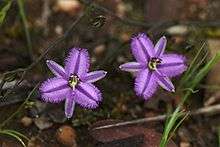Thysanotus patersonii
Thysanotus patersonii, the twining fringe-lily, is a climbing perennial herb which is endemic to Australia.
| Twining Fringe-lily | |
|---|---|
 | |
| Scientific classification | |
| Kingdom: | Plantae |
| Clade: | Tracheophytes |
| Clade: | Angiosperms |
| Clade: | Monocots |
| Order: | Asparagales |
| Family: | Asparagaceae |
| Subfamily: | Lomandroideae |
| Genus: | Thysanotus |
| Species: | T. patersonii |
| Binomial name | |
| Thysanotus patersonii | |
Description
Tuberous and leafless,[3] growing to between 0.15 and 0.5 metres in height.[4] They produce purple flowers between July and November in its native range.
Basal leaves disappear as the plant matures.[3] They ascend through the surrounding canopy by spiralling around nearby plants to attain a height between 0.6–0.8 metres.
Taxonomy
The species was first described by the botanist Robert Brown.[4]
Distribution
Thysanotus patersonii occurs across southern Australian states, excluding Queensland and the Northern Territory.[3][5][6] New South Wales flora online states that it is found in Queensland and the Northern Territory[7] and the electronic flora of South Australia excludes only the Northern Territory.[8]
Ecology
Strips of this plant are used by the red-eared firetail Stagonopleura oculata, a small bird in Southwest Australia, in the construction of their elaborate nests.[9]
The plant is used in urban landscapes and gardens, especially as a rockery specimen. It is grown from seed, favouring full sun and free drainage, and will trail out from rocks or loosely spiral up on neighbouring plants. Flowers are prolific and appear over spring and summer.[3]
References
- "Thysanotus patersonii ". Australian Plant Name Index (APNI), IBIS database. Centre for Plant Biodiversity Research, Australian Government, Canberra. Retrieved 5 June 2008.
- Brown, R. (1810) Prodromus florae Novae Hollandiae et insulae Van-Diemen, exhibens characteres plantarum quas annis 1802-1805: 284.
- Wrigley, J.W.; Fagg, M.A. (2003). Australian native plants : cultivation, use in landscaping and propagation (5th ed.). Sydney: Reed New Holland. p. 194. ISBN 1876334908.
- "Thysanotus patersonii". FloraBase. Western Australian Government Department of Parks and Wildlife.
- Stajsic, V. (2017) Thysanotus patersonii. Flora of Victoria, Royal Botanic Gardens Foundation, Victoria.
- Thysanotus parersonii occurrence data from the Australasian Virtual Herbarium
- S. McCune & D.W. Hardin. "New South Wales Flora Online: Thysanotus patersonii". Royal Botanic Gardens & Domain Trust, Sydney, Australia.
- "Thysanotus patersonii". Electronic Flora of South Australia Fact Sheet. State Herbarium of South Australia. 2007. Retrieved 5 June 2008.
- Forshaw, Joseph Michael; Shephard, Mark (2012). Grassfinches in Australia. CSIRO. pp. 64–75. ISBN 9780643096349.